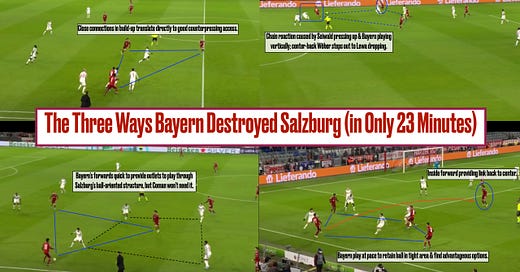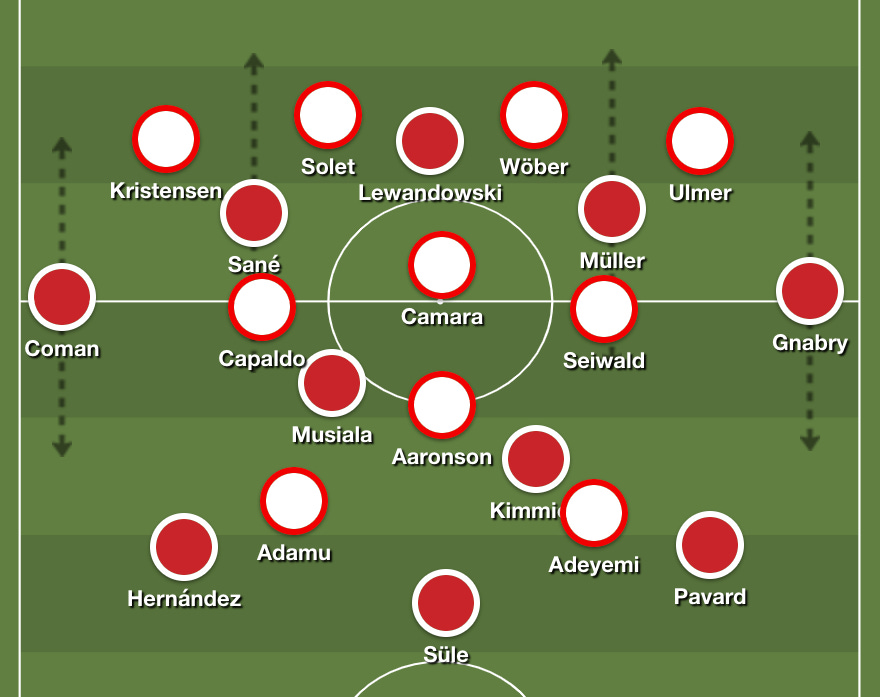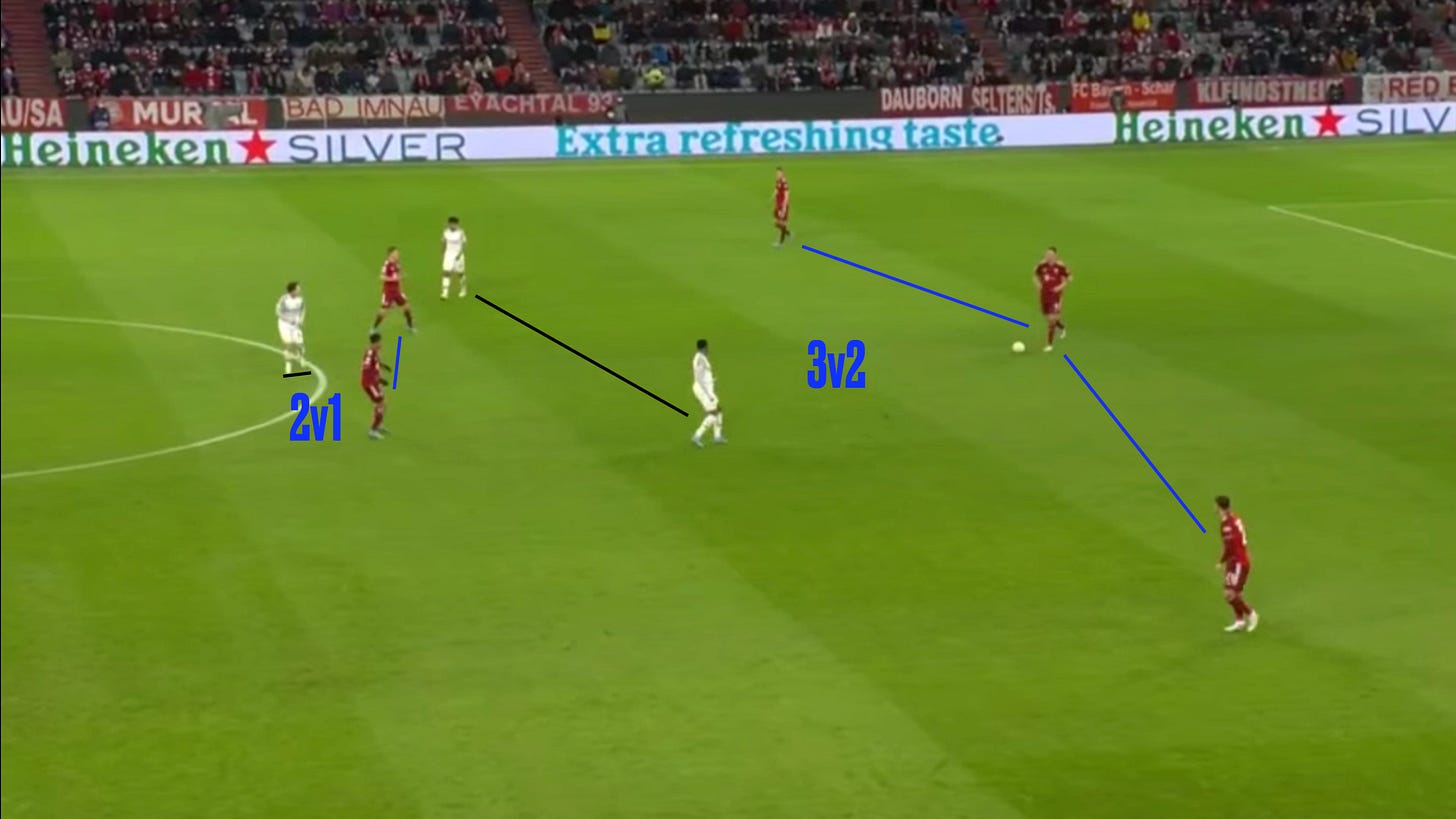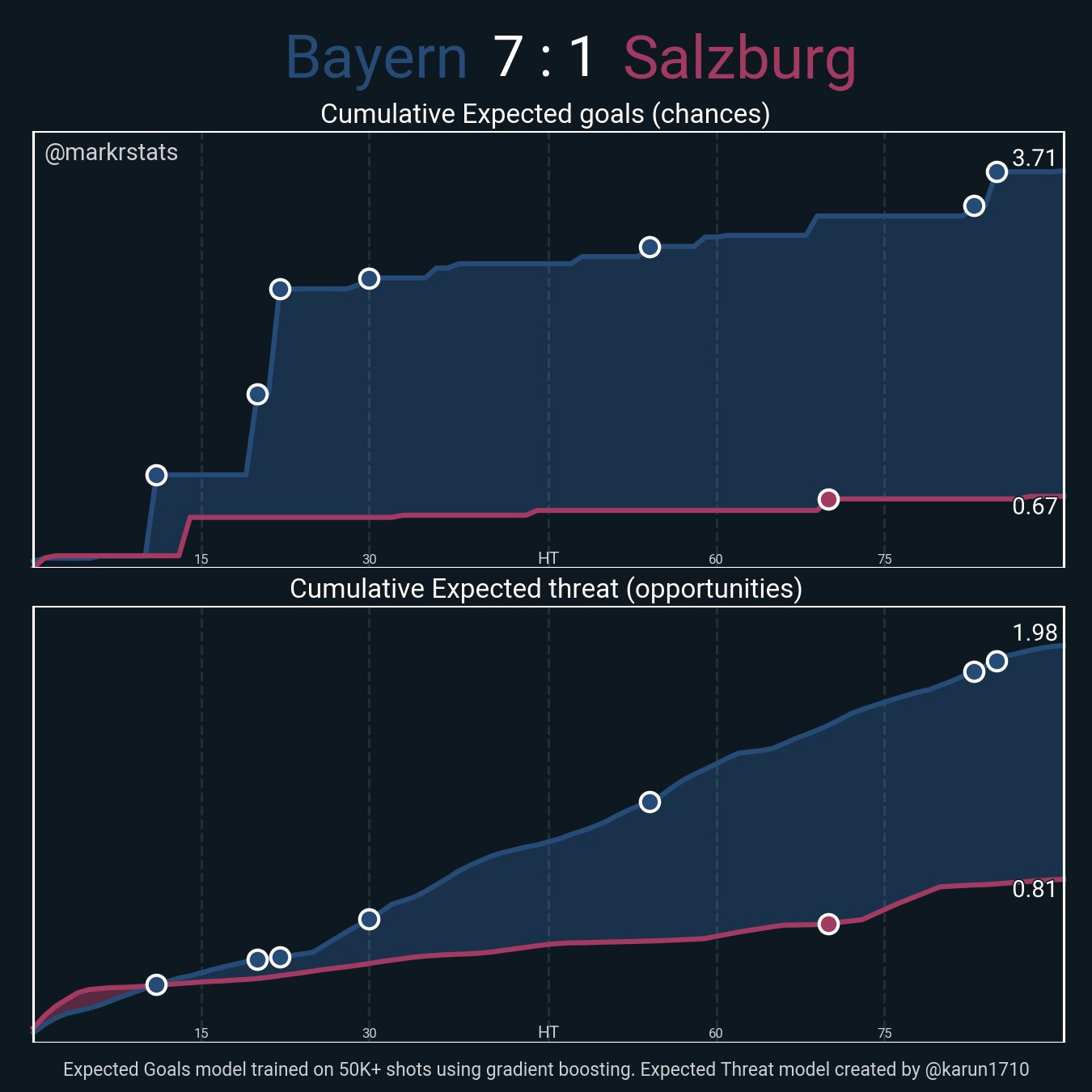The Three Ways Bayern Destroyed Salzburg (in Only 23 Minutes)
Julian Nagelsmann is building something terrifying.
All my Champions League content this season is paywalled. Consider subscribing to gain access. Keep reading for a free preview of the article.
While the shock factor of Julian Nagelsmann’s lineup vs. RB Salzburg in the second leg of the Champions League R16 was sizable for more casual Bundesliga viewers (like me), it was nothing particularly new.
For over a month, the 34-year-old coach has swapped between a 3-4-3/3-4-2-1 and 4-2-3-1 formation, having used almost the exact same eleven — wingers as wing-backs and all — vs. Salzburg in the first leg.
One of the two changes — Jamal Musiala replacing Coretin Tolisso — was the main cause for surprise, although even that was not completely novel. Musiala had played in a double pivot with Joshua Kimmich in the prior 1-1 draw against Bayer Leverkusen (albeit in a different formation) and Nagelsman had stated in February that he saw Musiala’s future in central midfield.
Nevertheless, these shifts had not immediately led to awe-inspiring results. Despite handily winning the xG battle vs. Salzburg in February, an aroma of defensive vulnerability wafted through their performance and the following fixtures.
Indeed, Musiala’s defensive capabilities were put under immediate scrutiny when he lost a fifty-fifty duel trying to cover the flanks inside 120 seconds, leading to a fantastic opportunity that Kingsley Coman only barely blocked.
In the 14th minute, a panicked Manuel Neuer long ball vs. the press resulted in a volley on target for Nicolas Seiwald.
NEW VIDEO LINK
By that time, Bayern were already 1-0 up, but one could be forgiven for thinking that Salzburg still had a chance due to the high-octane, oftentimes chaotic nature of the game. However, a sequence-by-sequence analysis of this short span of minutes reveals that the initiative was always Bayern’s. When combined with the nine minutes (and two goals) that followed, it becomes apparent that this dominance unfolded through three distinct patterns.
1. Exploiting Salzburg’s Lack of Width
Salzburg defended in typical Red Bull style, closing down the center of the pitch and looking to direct play out wide, where they could press quite aggressively in ball-oriented fashion; as Jesse Marsch has noted quite openly, the Ralf Rangnick school of thought doesn’t care about the far side, hence the narrow 4-3-1-2 shape deployed by Matthias Jaissle:
Bayern’s basic structure seemed set up to exploit everything about the way Salzburg defended. The back three created a 3v2 overload vs. Adamu and Adeyemi and the double pivot outmatched Brenden Aaronson in the second line.
The three forwards threatened the back of Salzburg’s midfield by offering to feet, while also creating a reliable base for a 5v4 advantage against Kristensen-Solet-Wöber-Ulmer when Coman and Gnabry were able to join the attack, which often occurred after they had overloaded Capaldo-Camara-Seiwald in the earlier phases of build-up.
This neatly-spaced offensive structure, which presented plenty of close passing connections and a free man in all zones, made it fairly easy for Bayern to find the far side in lethal fashion (and in every third), especially when combined with the pace which with they moved the ball.
NEW VIDEO LINK
This usually occurred from right to left:
Müller’s and Sané’s willingness to drop off as play progressed to the wing, combined with support from the double pivot and Lewandowski, created a tight nexus from which Bayern could continue to progress. As Salzburg recovered and packed the flank, The Bavarians used their nearby options, along with still-existing overloads, to nudge and pull defenders here and there, opening up space to move down the touchline for a cross, pass into the center, or switch to the far halfspace.
Bayern Munich’s numerical superiorities and incisive distribution made Salzburg’s pressers hesitate and hedge, urging them into motion only once the pass reached its destination, instead of as the ball was in motion — a fatal flaw for a Red Bull pressing system.
It is notable that Bayern’s two penalties (and, therefore, goals) originated from throw-ins. This highlighted the extent to which the German Champions were able to take advantage of Salzburg’s narrowness, as the Austrian outfit would bring everyone over to the near-side touchline on these occasions, disregarding the opposite half of the pitch.
If Bayern had operated at a generally lethargic pace, Salzburg might’ve been able to hang, but Nagelsmann’s men knew how to crank up the tempo at the right moments.
2. Rapid, Vertical Progressions
Bayern’s ability to stretch the press and play side-to-side organically opened up spaces through the middle, as one from the midfield line of three was forced to compensate for the overload at the back or cover dropping movements from attack.
While this was less common than the width exploitation described previously, Die Roten were viciously opportunistic at executing up-back-through patterns.
NEW VIDEO LINK
The offensive spacing naturally facilitated this, starting with a progressive pass into a vertical pocket from one of the wide CB’s, which a forward would drift into, thus, dragging someone with him and briefly creating a gap in Salzburg’s structure. In order to take advantage of this, there were a number of alternatives positioned underneath the receiver for the one/two-touch return ball (or wall pass). Given that these options would already be facing play, they could spot the next pass in an instant and keep the tempo flowing.
This process would repeat itself as necessary, zipping Bayern forward as Salzburg struggled to react, with help eventually having to come from the defensive line. In certain cases, such as the second example, Der FCB would seamlessly transition from progressing through the middle to a switch of play, having thoroughly collapsed Salzburg inwards and utilizing the handy overload from the double pivot.
3. Winning Second Balls
The early chances Bayern conceded suggests that chaotic sequences were their weakness, but they actually resulted in favorable outcomes for The Reds most of the time.
NEW VIDEO LINK
There is no doubt that luck played a role — especially on the third goal — as it always does in fifty-fifty duels. But, the specter of variance notwithstanding, Bayern were structured about as well as possible to deal with ping-pong sequences and their last-resort direct ball.
The beauty of it is that there was no need to change the base offensive shape to come out on top in these situations. The close-by links in possession made for excellent rest defense and the narrow front three provided immediate transition outlets following the counterpress.
When Bayern were able to play forward after a loose-ball duel or had to go long, Sané, Lewandowski, and Müller were invariably situated to combine with each other, play flick-ons, and secure the second ball.
It was a direct pass from Neuer that led to the 3-0 scoreline, reflecting the terrifying combination of tactical superiority and fortune that propelled Bayern to an unassailable position inside 23 minutes.
Although the tie was over then and there, the Bundesliga’s premier ambassador refused to let up, bringing their opponents to their knees and announcing their intent on the European stage.
The Intriguing, Mixed Identity of Nagelsmann
What makes the evolution of the young Nagelsmann so exciting is the way he blends that Red Bull verticality and aggression with more “Spanish” desires for control. As John Muller notes in his article on Jesse Marsch’s beginnings at Salzburg:
Under…Julian Nagelsmann, Red Bull’s flagship club had been relaxing its press, improving its passing, and playing more like the best teams in the world.
While the diehards from the Rangnick school “play to press,” as Juanma Lillo might put it, Nagelsmann’s Bayern “press to play,” but quicker and more intensely than perhaps a Pep Guardiola team.
Whether the tactical prodigy has managed to strike the perfect balance between these two tactical philosophies remains to be seen (as does Bayern’s defensive level vs. other European elite), but, as it stands, his special strategic blend can crush you in more ways than perhaps any other team on the continent, whether that be around you, through you, or over you.









